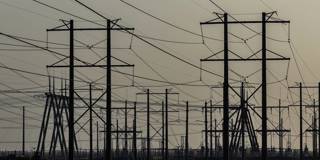Making the power sector fit for the twenty-first century requires a “banker” that finances and coordinates relevant long-term investments, and an “architect” that guides the development of a complex, interconnected smart-grid system. National governments need to fill both roles.
MILAN – Many of us take electricity for granted. We flip a switch and expect the light to turn on. But the capacity and resilience of power systems – generation, transmission, and distribution – are not guaranteed, and if these systems fail, it’s lights out for the entire economy.
I recently participated in a meeting of the Power and Energy Society (PES), which operates under the aegis of the Institute of Electric and Electronic Engineers. The mood at the event – attended by more than 13,000 industry professionals from around the world, plus hundreds of companies exhibiting advanced equipment and systems – was upbeat and energetic.
But, despite the prevailing “can-do spirit,” everyone at that meeting knew that the power sector is confronting tremendous challenges, beginning with the growing frequency of extreme weather events. Firms are now working to devise innovative ways to restore power more quickly after outages, and are investing in infrastructure that will increase resilience to shocks. This includes efforts to minimize the risk that the system itself will cause or exacerbate a shock, such as a forest fire.
Compounding the challenge, the power sector must make progress on the green transition. That means reducing its greenhouse-gas emissions, while maintaining a stable power supply for the economy. Since renewables work differently than fossil fuels, this implies a transformation not only of power generation, but also of transmission and distribution, including storage.
Meanwhile, demand for electricity is set to surge, owing to factors like electric-vehicle adoption and the rapid growth of data centers and cloud-computing systems. The power needs of artificial-intelligence systems, in particular, are expected to grow exponentially in the coming years. According to one estimate, the AI sector will be consuming 85-135 terawatt hours per year – about as much as the Netherlands – by 2027.
To meet these challenges, all three components of the power system need to be integrated in so-called smart grids, which are managed by digital systems and, increasingly, AI. But developing smart grids is no small feat. For one thing, they require a host of devices and systems, such as residential smart meters and distributed energy resource management systems (DERMS), which are needed to manage multiple flexible and fluctuating energy sources and integrate them into power networks. And, because they are built on digital foundations, effective cybersecurity systems are essential to support stability and resilience.
None of this will come cheap. The International Energy Agency estimates that, if the world economy is to reach net-zero emissions by 2050, annual investment in smart grids will need to double – from $300 billion to $600 billion – globally through 2030. This represents a significant share of the estimated $4-6 trillion that will be needed annually to finance the overall energy transition. But, so far, the required investment has not been forthcoming. Even in advanced economies, the smart-grid funding gap exceeds $100 billion.
Meeting all these challenges will require coordinated action across what are often highly complex systems. The United States is a case in point. America’s roughly 3,000 electric utilities operate in various combinations of generation, transmission, and distribution, as well as playing a market-making role as intermediaries between generation and distribution. Each US state has its own regulators, and local distribution can be regulated at the municipal level. America’s nuclear infrastructure is managed at the federal level, by the Department of Energy, which also funds research and, under the 2022 Inflation Reduction Act, finances investment in the power sector. And the US Environmental Protection Agency plays a major role in setting the direction and pace of the energy transition.
Other entities oversee the country’s three major grid regions and the interconnections among them. For example, the not-for-profit North American Electric Reliability Corporation is responsible for six regional entities that together cover all the interconnected power systems of Canada and the contiguous US, as well as a portion of Mexico.
Achieving the necessary transformation of power systems will require us to figure out how to finance the relevant investments, who will ultimately pay for them, and how a complex, technologically sophisticated, and rapidly evolving smart-grid system can be coordinated.
It is difficult to imagine how investment could be mobilized at the scale necessary without the financing power of national governments. This is especially true in the US, where there is no shared carbon price to level the playing field. It is thus good news that, last month, President Joe Biden’s administration announced a range initiatives and investments designed to support and accelerate structural change in the power sector.
As for who should pay, the answer is complicated. In principle, investments that reduce costs or augment service quality and stability should be reflected in tariffs. The problem is that the investments that improve service quality must be spread across multiple entities that own different assets in the grid. Highly decentralized regulatory structures would make coordinating all these tariff changes and transfers unwieldy, at best.
When it comes to investments that advance the green energy transition – including the global public good of emissions reduction – we know who should not pay: local communities. In fact, the implementation of local-level charges to finance such investments is bound to lead to inefficiencies and underinvestment. It would also be unfair: there is no good reason why consumers in areas with problematic legacy systems should pay more. If they are asked to, they are likely to resist.
A better approach would be to use an expanded federal industrial policy not only to help finance and especially to coordinate long-term investments in the power sector, but also to guide the development of a complex, interconnected smart-grid system. This system needs a banker and an architect working with firms, regulators, investors, researchers, and industry organizations like the PES to carry out a complex, fair, and efficient structural transformation. National governments need to be involved in filling both roles.











MILAN – Many of us take electricity for granted. We flip a switch and expect the light to turn on. But the capacity and resilience of power systems – generation, transmission, and distribution – are not guaranteed, and if these systems fail, it’s lights out for the entire economy.
I recently participated in a meeting of the Power and Energy Society (PES), which operates under the aegis of the Institute of Electric and Electronic Engineers. The mood at the event – attended by more than 13,000 industry professionals from around the world, plus hundreds of companies exhibiting advanced equipment and systems – was upbeat and energetic.
But, despite the prevailing “can-do spirit,” everyone at that meeting knew that the power sector is confronting tremendous challenges, beginning with the growing frequency of extreme weather events. Firms are now working to devise innovative ways to restore power more quickly after outages, and are investing in infrastructure that will increase resilience to shocks. This includes efforts to minimize the risk that the system itself will cause or exacerbate a shock, such as a forest fire.
Compounding the challenge, the power sector must make progress on the green transition. That means reducing its greenhouse-gas emissions, while maintaining a stable power supply for the economy. Since renewables work differently than fossil fuels, this implies a transformation not only of power generation, but also of transmission and distribution, including storage.
Meanwhile, demand for electricity is set to surge, owing to factors like electric-vehicle adoption and the rapid growth of data centers and cloud-computing systems. The power needs of artificial-intelligence systems, in particular, are expected to grow exponentially in the coming years. According to one estimate, the AI sector will be consuming 85-135 terawatt hours per year – about as much as the Netherlands – by 2027.
To meet these challenges, all three components of the power system need to be integrated in so-called smart grids, which are managed by digital systems and, increasingly, AI. But developing smart grids is no small feat. For one thing, they require a host of devices and systems, such as residential smart meters and distributed energy resource management systems (DERMS), which are needed to manage multiple flexible and fluctuating energy sources and integrate them into power networks. And, because they are built on digital foundations, effective cybersecurity systems are essential to support stability and resilience.
SPRING SALE: Save 40% on all new Digital or Digital Plus subscriptions
Subscribe now to gain greater access to Project Syndicate – including every commentary and our entire On Point suite of subscriber-exclusive content – starting at just $49.99.
Subscribe Now
None of this will come cheap. The International Energy Agency estimates that, if the world economy is to reach net-zero emissions by 2050, annual investment in smart grids will need to double – from $300 billion to $600 billion – globally through 2030. This represents a significant share of the estimated $4-6 trillion that will be needed annually to finance the overall energy transition. But, so far, the required investment has not been forthcoming. Even in advanced economies, the smart-grid funding gap exceeds $100 billion.
Meeting all these challenges will require coordinated action across what are often highly complex systems. The United States is a case in point. America’s roughly 3,000 electric utilities operate in various combinations of generation, transmission, and distribution, as well as playing a market-making role as intermediaries between generation and distribution. Each US state has its own regulators, and local distribution can be regulated at the municipal level. America’s nuclear infrastructure is managed at the federal level, by the Department of Energy, which also funds research and, under the 2022 Inflation Reduction Act, finances investment in the power sector. And the US Environmental Protection Agency plays a major role in setting the direction and pace of the energy transition.
Other entities oversee the country’s three major grid regions and the interconnections among them. For example, the not-for-profit North American Electric Reliability Corporation is responsible for six regional entities that together cover all the interconnected power systems of Canada and the contiguous US, as well as a portion of Mexico.
Achieving the necessary transformation of power systems will require us to figure out how to finance the relevant investments, who will ultimately pay for them, and how a complex, technologically sophisticated, and rapidly evolving smart-grid system can be coordinated.
It is difficult to imagine how investment could be mobilized at the scale necessary without the financing power of national governments. This is especially true in the US, where there is no shared carbon price to level the playing field. It is thus good news that, last month, President Joe Biden’s administration announced a range initiatives and investments designed to support and accelerate structural change in the power sector.
As for who should pay, the answer is complicated. In principle, investments that reduce costs or augment service quality and stability should be reflected in tariffs. The problem is that the investments that improve service quality must be spread across multiple entities that own different assets in the grid. Highly decentralized regulatory structures would make coordinating all these tariff changes and transfers unwieldy, at best.
When it comes to investments that advance the green energy transition – including the global public good of emissions reduction – we know who should not pay: local communities. In fact, the implementation of local-level charges to finance such investments is bound to lead to inefficiencies and underinvestment. It would also be unfair: there is no good reason why consumers in areas with problematic legacy systems should pay more. If they are asked to, they are likely to resist.
A better approach would be to use an expanded federal industrial policy not only to help finance and especially to coordinate long-term investments in the power sector, but also to guide the development of a complex, interconnected smart-grid system. This system needs a banker and an architect working with firms, regulators, investors, researchers, and industry organizations like the PES to carry out a complex, fair, and efficient structural transformation. National governments need to be involved in filling both roles.